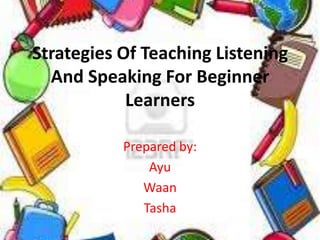Strategies for listening and speaking for beginners
This document outlines strategies for teaching listening and speaking skills to beginner language learners. It recommends using Total Physical Response (TPR) techniques like commands that require physical responses, as well as games that encourage describing objects and asking questions. Songs are suggested to help students learn pronunciation and vocabulary. Specific activities proposed include information gap activities, opinion sharing, role-playing, games, and everyday classroom interactions. The document provides tips for teacher speech like using clear instructions and limiting jargon, as well as keeping sentences short and simple for young learners. Other techniques mentioned are allowing group work, using teaching materials, storytelling, poetry, and listening to music.

Recommended
Recommended
More Related Content
What's hot
What's hot (20)
Viewers also liked
Viewers also liked (20)
Similar to Strategies for listening and speaking for beginners
Similar to Strategies for listening and speaking for beginners (20)
Strategies for listening and speaking for beginners
- 1. Strategies Of Teaching Listening And Speaking For Beginner Learners Prepared by: Ayu Waan Tasha
- 2. Total Physical Response (TPR) Games Songs
- 3. Total Physical Response (TPR) • This technique creates situations where students must physically respond to imperative commands. • Games like “Simon Says” are a great example of how TPR works. • It’s a fun and interactive technique for developing beginners’ listening and comprehension skills in a non-threatening way.
- 4. Games “What’s inside the bag?” and “What can we do with this?” It gives students the chance to describe everyday objects in their own words and ask one another questions; They forget their nervousness in unrehearsed speech and begin to speak more fluently, make stronger eye contact, and become more comfortable asking for clarification.
- 5. Songs A great way for pupils to learn to understand and use the local accent. Introduces new vocabulary to the pupils.
- 6. Specific Strategies/Activities: • Teaching oral language - To develop oral communication skills, focus on activities that encourage learners to talk in a supportive environment such as in pairs or groups.
- 7. Specific Strategies/Activities: Such activities include: Information gap activities where learners have to exchange information in order to complete a task opinion gap activities where learners share and discuss their own personal feelings, attitudes or preferences about ideas or topics mime and role-play general communicative activities e.g. games, group work, songs everyday classroom interactions
- 8. Teacher talk • Keep talk to a minimum • Use clear, common and consistent instructions and repeat or rephrase if necessary • Speak at a normal pace and volume • Don’t use too much jargon • Support instructions with visual cues as much as possible
- 9. Tips for teaching listening to young learners • Keep sentences short and grammatically simple • Use exaggerated intonation to hold the child's attention • Emphasize key words • Limiting the topics talked about to what is familiar to the child • Frequently repeating and paraphrasing
- 10. Other ways; Allow group work Use teaching materials Story telling Poetry Listening to music
- 11. THANK YOU
